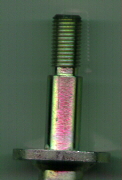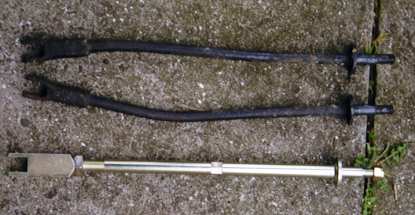Here is a message posted on the mini-list:
Date: 03-Jul-1999 19:02:20
From: "Piers Coe" Piers.Coe@btinternet.com
Subject: adjustable tie-bars -- BEWARE !
Coming back from a night out on Friday .. going down a road with some mild
speed-bumps in it, doing about 15mph .. about 10 meters after one of the bumps there was a
large clunk ..
followed by the sound of wheel rubbing the arch .. and the car steered
itself towards the ditch !!
It was just about all I could do to hold it straight..
anyway .. after coming to a halt and getting out of the car ..
I walked round to the passenger side and to my horror saw the front left
wheel had suddenly gained
about 25 degrees of negative camber !! and about 20 degrees of tow-out..
while the right-hand wheel was straight !!
Anyway .. investigation the following morning identified a broken tie-rod..
It had snapped at the end nearest the front of the car, just where the
thread ends.
the wheel had therefore been wrenched backwards and had bent the lower arm
pivot bolt (significantly!!).
Luckily the subframe wasn't bent, so a new pivot bolt was fitted along with
the old origional tie-bars ..
I put both the old tie-bars back on as I didn't fancy the same thing
happening doing 60mph down a dual-carrigeway or something !!
I can see where the fault occured ..
the threaded section has first been machined down to a smaller size than the
rest of the bar, and where this smaller section meets the larger diameter
section, there is a right-angle .. no bevel or blending in, but just a
right-angle...
I looked at the origional tie-bars at hte same place - and these have a
small bevel between the two diameters ...
Anyway .. Just thought I should inform you all, and see if anyone else had
had any rpoblems like this ?!?!? (I hope not !!)
Yours
Piers Coe.
Piers' tie rods came from the Mini Shop in England.

This picture resides on Piers' website.
My Problem
Now, I've just bought a pair of tie rods from Mini Services that originally came from Mini Spares in the UK. The enclosed
fitting instructions call them "21A1091 HEAVY DUTY ADJUSTABLE TIE RODS". Does my tierod suffer
from this problem?? Here is a picture of the offending end. Remember, these are my Tie Rods, not Piers

Piers comments on this picture:
From: Piers Coe
To: MiniList
Subject: RE: Tie-rod pics !!!
Date: Fri, 16 Jul 99 05:23:01
TO everyone .. and especially Tom ..
The pics of your tie-bars that you posted ..
They look exactly the same as mine !!
What Paul said about the thin section is right - that is exactly where mine
broke !!!
Just so you all know exactly what I was talking about !!
Piers .
Kelly Mascher's comments
From: Kelley Mascher
To: Mini List
Subject: RE: Tierod pictures up
Date: Fri, 16 Jul 99 03:34:00
The necking on Tom's tie rod is about right
in diameter. Keep in mind that this end of the
tie rod floats on rubber or polyurethane
bushings. Torque is limited by the compliance
of the bushing. If you tighten them down until
there is no compliance left in the bushing then
something is going to break. Usually it's the
subframe ear but it could just as easily be
the threaded portion of the rod.
The last thread or the end of the threading
is a major stress raiser. Necking, if done
properly, gives the stress raiser nowhere to
go. The reduction in strength from the necking
is minor compared to the guaranteed break
that will occur at the end of the thread.
Die cut or single point cut threads cause much
bigger problems than rolled threads. My guess
is that the original tie rods have rolled
threads and are made of more ductile material
less prone to cracks. Heavy duty often means
harder material which usually means more
brittle material. Hence the devlopment of
cracks at sharp edges.
Looking at the picture, the transition from the
threads to the necked portion looks very abrupt.
The bottom of the neck should have a generous radius.
It could just be the angle of the picture, it's hard
to tell. If the thread side is sharper than the
bushing side of the neck then I would suspect that
this is the point where Piers' let go. Not because
of the reduction in diameter of the material but
because in trying to eliminate the stress raiser
from the threads they created another, perhaps
worse, one at the bottom of the neck.
Cheers,
Kelley Mascher (206) 528-2713
Children's Hospital & Med. Center mascher@u.washington.edu
Audiology Research Seattle, Washington USA
My Thoughts
I'm very annoyed. I have to either get these tierods replaced, or have them machined to put a bevel on the step from the small
diameter to the larger diameter. I do not know if beveling the step is a suitable option. I will update this page when I know
more about the beveling option.
Update
Murrey Lockie, of Mini Services, where I got the tierods, is very sure that these tierods are not going to break, that they are
a different design to the mini shop ones (although they look VERY similar) and that I shouldn't have anything to worry about.
Further Update
I cracked the subframe where the tierod mounts. There appears to be no damage to the tierod, so I guess they are strong enough.
My Tierods
These went curly during a speed event our club held. The shiney one is one of the the new rods I got from
Mini Services.



